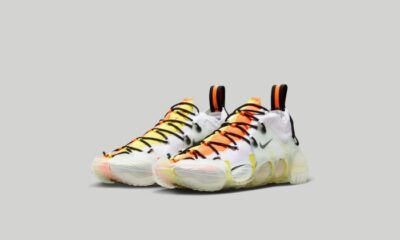Education
Silk From Spiders And Silkworms Found To Be A Promising Material To Repair Injured Nerves

- New study shows that tubes made from natural silk materials offer a promising way to repair large gap nerve injuries.
- Nerve cells migrated with ‘remarkable speed’ through the tubes to successfully repair large gap nerve injuries in rats.
- Researchers intend to commercialise the technology into an ‘off-the-shelf’ treatment for human nerve injuries.
Nerve guides made of natural or synthetic materials are an important surgical tool for nerve repair. These are tubes that are sutured to both ends of an injured nerve to guide the growth of nerve fibers and cells across the gap. Currently, however, these can only be used to bridge very small distances. It was thought that a key reason for this limitation was the lack of an internal framework to act as a “handrail” along which the regenerating tissue can orient itself and grow.
In a new study published in the journal Advanced Healthcare Materials, researchers from the University of Oxford and MedUni Vienna developed a novel type of nerve guide using two different types of natural silk. The tube wall was manufactured from silk produced by silkworms (Bombyx mori), and the inside filled with dragline silk fibers from golden orb-web spiders (Trichonephila edulis). The tubes were tested in rats whose right sciatic nerve had been cut, creating a 10 mm gap (a significant length for a rat). The researchers found that the damaged nerves adapted to the novel silk nerve guides and grew along the silk threads until the severed endings successfully reconnected.
The research team used advanced microscopy techniques to analyse the healing process in detail. This showed that the silk tubes had a highly porous structure; an essential feature for nerve regeneration since this allows nutrients and waste materials to be exchanged. In addition, Schwann cells, the key drivers of peripheral nerve regeneration, adhered strongly to both the tube walls and the dragline silk fibers, and migrated with remarkable speed (over 1.1 mm per day).
The study further demonstrated that both types of silk played an important part in nerve regeneration. When nerve injuries were repaired using empty silk tubes, without the spider silk filling, the nerve fibers grew more slowly and were less organized.
The silkworm silk tubes were supplied by Oxford Biomaterials, a company that was spun out of Oxford University in 2001 to exploit the biomimetic spinning technology developed by the Oxford Silk Group, part of the Department of Biology. Professor Fritz Vollrath, a co-founder of Oxford Biomaterials and a co-author on this study, said: ‘Animal silks offer exceptional mechanical and biological properties and versatile manufacturing possibilities to assist the re-engineering of tissue. Our advanced silk-in-silk nerve guides combine the excellent ability of silkworm silk to be processed into three dimensional structures with the outstanding cell adhesion qualities of spider dragline silk.’
He added that using natural materials for nerve guides has many advantages over synthetic substances. Spider silk, for instance, degrades over time and produces hardly any immune response in animal models. They can also be highly abundant: a single harvest from an orb-web spider can yield around 10 m of silk, enough to fill a 10 mm long nerve guide. Meanwhile, the porous structure of the tube walls made from silkworm silk presents versatile possibilities to incorporate bioactive molecules, such as growth factors, to promote nerve regeneration over longer distances.
Ultimately, the team hope to develop the silk nerve guides into an “off-the-shelf” solution to treat nerve injuries in humans. Currently, human nerve injuries with large gaps are often treated by grafting nerves harvested from other areas of the patient’s body (called autografts). However, this process has many drawbacks, including a limited availability of donor nerves, lengthy operations, and the possibility of further harm for the patient. In this study, nerve regrowth and functional regain was similar for injuries repaired using the silk nerve guides or grafted nerves.
Newrotex Ltd, a spin-out company from Oxford Biomaterials, are developing silk technologies for treating nerve injuries and are completing final pre-clinical studies with the aim of bringing a functional device suitable for humans to the market. Its CEO and founder, Dr Alex Woods, is a trauma orthopaedic surgeon at Oxford University Hospitals and holds a DPhil in Zoology and a Bachelor of Medicine, Bachelor of Surgery from Oxford University.
Dr Woods said: ‘Peripheral nerve injuries have a devastating impact on patients world-wide. This
study provides further evidence of the incredible regenerative properties of silk within the nervous system and demonstrates its exciting utility and potential as a material to address the unmet clinical need for an “off-the-shelf” technology to treat nerve injuries.’
Notes for editors:
For media enquiries and interview requests with the research team contact Professor Fritz Vollrath: fritz.vollrath@biology.ox.ac.uk
Images of the silk tubes, regrowing nerve cells and golden orb-web spiders are available on request. Please contact Dr Caroline Wood: caroline.wood@admin.ox.ac.uk
The study ‘Silk-in-silk nerve guidance conduits enhance regeneration in a rat sciatic nerve injury model’ has been published in Advanced Healthcare Materials: https://onlinelibrary.wiley.com/doi/abs/10.1002/adhm.202203237
About the University of Oxford
Oxford University has been placed number 1 in the Times Higher Education World University Rankings for the seventh year running, and number 2 in the QS World Rankings 2022. At the heart of this success are the twin-pillars of our ground-breaking research and innovation and our distinctive educational offer.
Oxford is world-famous for research and teaching excellence and home to some of the most talented people from across the globe. Our work helps the lives of millions, solving real-world problems through a huge network of partnerships and collaborations. The breadth and interdisciplinary nature of our research alongside our personalised approach to teaching sparks imaginative and inventive insights and solutions.
Through its research commercialisation arm, Oxford University Innovation, Oxford is the highest university patent filer in the UK and is ranked first in the UK for university spinouts, having created more than 200 new companies since 1988. Over a third of these companies have been created in the past three years. The university is a catalyst for prosperity in Oxfordshire and the United Kingdom, contributing £15.7 billion to the UK economy in 2018/19, and supports more than 28,000 full time jobs.
The Department of Biology is a University of Oxford department within the Maths, Physical and Life Sciences Division. It utilises academic strength in a broad range of bioscience disciplines to tackle global challenges such as food security, biodiversity loss, climate change and global pandemics. It also helps to train and equip the biologists of the future through holistic undergraduate and graduate courses. For more information visit www.biology.ox.ac.uk.
Source – University Of Oxford
-

 Auto1 year ago
Auto1 year agoHonda Marine Debuts All-New BF350 Outboard Company’s First V8 Motor Available Commercially, Flagship Model Offers Premium Power and Unparalleled Performance for Extraordinary Boating Experiences
-

 Lifestyle1 year ago
Lifestyle1 year ago2023 Nike World Basketball Festival Brings the Best of Basketball Style, Culture and Community
-

 Auto1 year ago
Auto1 year agoNew Features Further Increase Desirability Of Bentayga Range
-

 Lifestyle1 year ago
Lifestyle1 year agoNike Debuts the ISPA Link Axis, an Exploration Into Circular Design
-

 Auto1 year ago
Auto1 year agoHonda and Acura Electric Vehicles Will Have Access to Largest EV Charging Networks in North America Aided by New Agreements with EVgo and Electrify America
















